Sydney Brenner captivates UPF during his investiture ceremony as doctor honoris causa
Sydney Brenner captivates UPF during his investiture ceremony as doctor honoris causa
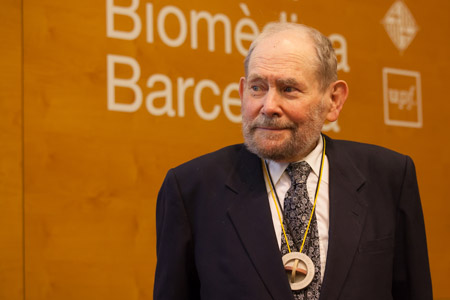
Sydney Brenner, Nobel Prize laureate in physiology or medicine, who is considered one of the architects of modern biology, has been awarded a doctorate honoris causa by UPF. He is the first scientist to receive this honour from the University, in recognition of his brilliant career in teaching and research in the field of molecular biology, which has made him one of the world's leading names in this field of knowledge.
The investiture ceremony, presided over by Mireia Trenchs, acting rector of UPF (the rector Jaume Casals was away on institutional business in the United States) took place on the Mar Campus at noon on 3 April, in the auditorium of the Biomedical Research Park (PRBB), which was full to overflowing. Also sitting at the presiding table were Francesc Posas, Director of the Department of Experimental Sciences and Health (CEXS) and Pelegrí Viader, general secretary of UPF.
The event, which was broadcast live on the University's website, was attended by Claudi Alsina, the general secretary of the Inter-University Council of Catalonia;Jordi Camí, general manager of the PRBB, as well as teaching and research staff at UPF and the various research centres in the park, students, members of the university community and various academic and institutional dignitaries.
Arcadi Navarro, a professor at the CEXS, was the sponsor of the ceremony and accompanied Sydney Brenner (who signed the UPF Book of Honour before the start of the event) throughout. The doctoral encomium was given by the lecturers Miguel Beato, a researcher at the Centre for Genomic Regulation (CRG) and Fernando Giráldez and Jaume Bertranpetit, professors at the CEXS.
- Opening of the ceremony
- Encomia
- Acceptance speech by Sydney Brenner
- Performance of Verbum (Genome in Music)
- Speech by Mireia Trenchs and conclusion
- Image gallery of the investiture ceremony
Opening of the ceremony
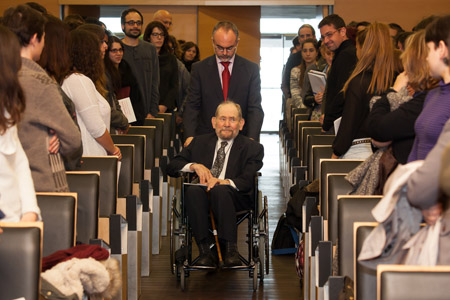 The procession of academic authorities entered the auditorium to the chords of La nuit, by Jean-Philippe Rameau. After Mireia Trenchs began the proceedings with some welcoming remarks, Pelegrí Viader read the agreement of the Board of Governors to award the title of Doctor Honoris Causa to Sydney Brenner at the request of the CEXS and the Faculty of Health and Life Sciences.
The procession of academic authorities entered the auditorium to the chords of La nuit, by Jean-Philippe Rameau. After Mireia Trenchs began the proceedings with some welcoming remarks, Pelegrí Viader read the agreement of the Board of Governors to award the title of Doctor Honoris Causa to Sydney Brenner at the request of the CEXS and the Faculty of Health and Life Sciences.
The sponsor, Arcadi Navarro, and the doctorand solemnly entered the auditorium to the strains of the song What a Wonderful World, by George David Weiss and Bob Thiele. This was followed by the reading of the three encomia, which referred to Brenner's main contributions to molecular biology, developmental biology and evolutionary biology, respectively.
Encomia
> The three encomia to Sydney Brenner (PDF document, 500 Kb, in English)
The first encomium, on "Sydney Brenner's contributions to molecular biology" was read by Miguel Beato, who met Sydney Brenner in the 1990s, and focused on his career and academic training: "What Sydney Brenner has actually chosen to do throughout his long scientific life has been to open up new areas of research, including molecular biology," he said.
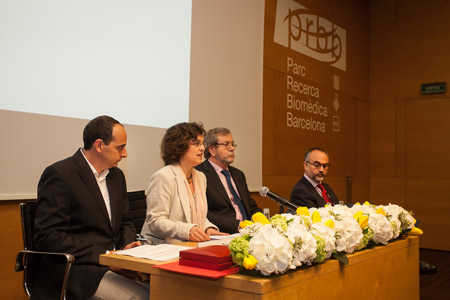
The CRG researcher revi ewed the universities and research centres which have been associated with Professor Brenner, the scientists with whom he has worked (including James Watson and Francis Crick, discoverers of the famous double helix structure of DNA) and his main achievements: "It is clear that Brenner has been one of the intellectual pillars of molecular biology, and an indefatigable champion of research on every continent. I doubt that UPF could have chosen a better life scientist as a doctor honoris causa," he concluded.
Fernando Giráldez then rose to the pulpit to pronounce the second encomium, which he wrote in collaboration with Cristina Pujades, a tenured lecturer at the CEXS. Professor Giráldez explained in detail the important contributions of Dr Brenner in the field of developmental biology, in which a single cell, the zygote, becomes a totally different part of the organism.
Among the research he mentioned was the work done on the regions of DNA that regulate the expression of genes that constitute the genome of vertebrates; and the system model that he created with his ex-students John Sulston and Robert Horovitz, which led to them receiving the Nobel Prize in physiology or medicine in 2002: during their research on gene regulation, development and programmed cell death, they found an organism (the worm Caenorhabditis elegans), which was simple enough to be able to monitor its overall development and to describe on a cell by cell basis.
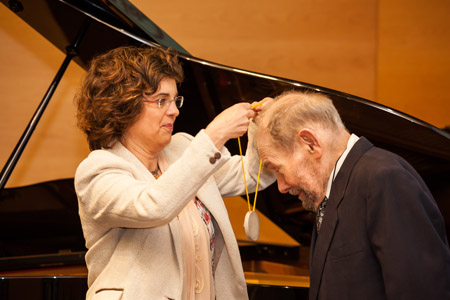 The CEXS professor praised the research work done by multidisciplinary teams, as understood by Dr Brenner: "Collaborative groups generate free environments with no disciplinary boundaries. This promotes a culture of enhanced freedom, allowing scientists to pursue long-term projects of great significance - in short, a pathway to challenge dogmas."
The CEXS professor praised the research work done by multidisciplinary teams, as understood by Dr Brenner: "Collaborative groups generate free environments with no disciplinary boundaries. This promotes a culture of enhanced freedom, allowing scientists to pursue long-term projects of great significance - in short, a pathway to challenge dogmas."
The third and last encomium, on "Sydney Brenner's Gift to Science" was given by Jaume Bertranpetit: "Sydney Brenner may be considered the scientific advisor for all of us; he has stirred up most of our fields of research," he stressed. Professor Bertranpetit structured his speech using a representative selection of excerpts from the autobiography My Life is Science, written by Errol C. Friedberg, referring to various moments in Brenner's life.
These included the importance of genetics in explaining complex structures in higher organisms; the explanation of the human genome, with many parts of the genetic material that remain in the genome despite not having a specific function; various considerations on systems biology, about which Brenner disagreed with some researchers and with some perspectives and ways of working; and a reflection on a statement by Brenner himself ("living organisms are the only part of the natural world that contain an internal description of themselves"), were the main aspects highlighted by Professor Bertranpetit.
The most moving moment in the ceremony came with the investiture of the doctorand, when Mireia Trenchs awarded Sydney Brenner the doctor honoris causa medal and embraced him as a sign of welcome and acceptance to the University's Senate of Doctors.
Sydney Brenner's acceptance speech
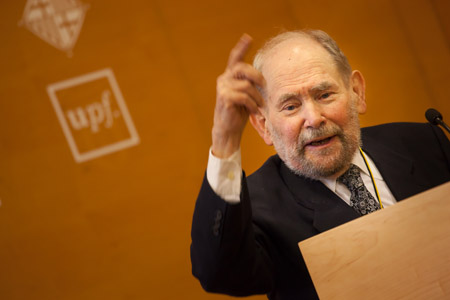 Sydney Brenner took the floor to deliver his acceptance speech, which was widely applauded by an audience that was immediately able to engage with his casual and informal style.
Sydney Brenner took the floor to deliver his acceptance speech, which was widely applauded by an audience that was immediately able to engage with his casual and informal style.
> Sydney Brenner's acceptance speech (pdf document, 431 Kb.)
Professor Brenner emphasized the honour involved in receiving the doctorate and stressed the importance of science in the long term as a "key to solving problems" and as "the passion that should drive researchers."
After stressing the importance of the context in which work in biology is carried out in order to understand how it works ("computational systems will never be able to explain the vicissitudes to which evolution has been subject to for centuries"), he said that scientific research is the only way of solving the mysteries that will arise in the future - a role that neither magic nor religion can play.
Professor Brenner praised the university as an institution and the education of future generations, because they will design the economy that will govern the world within a few decades. "Humans are the most important animal species on the planet. We have to think about the future, because other species can't do it," he stressed.
> Sydney Brenner's acceptance speech
Performance of Verbum (Genome in Music )
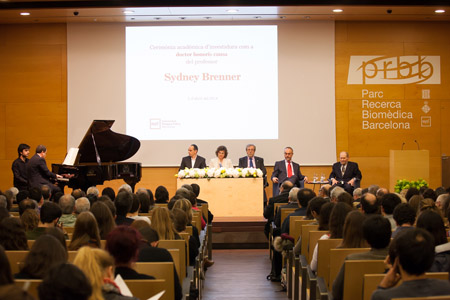 Then came the most artistic part of the ceremony, with the performance of Verbum (Genome in Music), a piece of music about the human genome written for the piano by the composer Joan Guinjoan (who was present at the event). The piece, which was a commissioned by the CSIC-Government of Catalonia Residence for Researchers, was performed for the first time in 2003, and reflects the poetical and musical transcription of the gene sequence associated with speech, FOXP2, which is located on chromosome 7.
Then came the most artistic part of the ceremony, with the performance of Verbum (Genome in Music), a piece of music about the human genome written for the piano by the composer Joan Guinjoan (who was present at the event). The piece, which was a commissioned by the CSIC-Government of Catalonia Residence for Researchers, was performed for the first time in 2003, and reflects the poetical and musical transcription of the gene sequence associated with speech, FOXP2, which is located on chromosome 7.
By composing this piece, which was performed by the pianist Alfonso Calderón de Castro during the investiture ceremony at UPF, Joan Guinjoan intertwines the world of science and the world of culture: he combines musical creation with one of the most important events of our time, the deciphering of the human genome, which provided the creative stimulus and the pretext for writing a piece of musical interest.
From the 30,000 genes that are believed to make up the human genome, the bioinformatics lecturers at the CEXS-UPF Roderic Guigó and Francesc Abril, who authored the first publication on the human genome in the journal Science in 2001, provided the composer Guinjoan with the sequence of the gene FOXP2, which he depicted musically.
Genetic separation and reconstitution through music
Verbum, the expression of a balance between form and essence, is based on the breakdown and reconstitution of part of the speech gene, in an image that could be translated as a process based on incoherence and the many phonetic effects that the voice can produce, until normal speech is attained.
The language used in the piece of music varies widely and has been freely created, but a transcription of the four chemical letters, or bases of genetic code is nevertheless a recurring theme: adenine (A), thymine (T), cytosine (C) and guanine (G), which are translated into the sounds A, C and G, and which have been used to create a musical "cell". This cell, which is repeated throughout the piece, has been crafted from various combinations and variations.
The first part of the score is uses a progressive chaotic and tense atmosphere to reach a climax, equivalent to the separation process. From a conceptual point of view, it reinforces the evocation of the DNA double helix using melodic and harmonic progressions, as well as the fragments consisting of twenty chords or sounds inspired by the description of amino acids.
The second part (calmo i libero), aims to musically translate the gene's reconstitution from speech, using a long phrase consisting of periods, which are presented with different characters, from intimacy to exuberance. This is followed by a brief but highly lyrical interlude, at the end, with the molto tranquilo surrounded by a serene and evocative atmosphere that is the equivalent of the establishment of the genome's order.
> Performance of Verbum (Genome in Music), by Joan Guinjoan, by the pianist Alfonso Calderón de Castro
Speech by Mireia Trenchs and conclusion
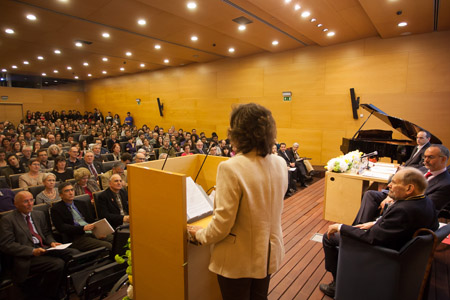 The final speech in the ceremony was given by Mireia Trenchs, who began by highlighting the importance of the CEXS as a research centre of excellence, which aims to achieve an international profile and recognition and presence in the fields of molecular biology and biomedicine.
The final speech in the ceremony was given by Mireia Trenchs, who began by highlighting the importance of the CEXS as a research centre of excellence, which aims to achieve an international profile and recognition and presence in the fields of molecular biology and biomedicine.
> Speech by Mireia Trenchs (PDF document, 143 Kb, in English)
The acting rector said of the new doctor honoris causa that "his words and his goals will become an inexhaustible source of inspiration for the junior and senior teams in our Experimental and Health Sciences area." She added: "I hope that Dr Brenner's devotion to the advancement of science and multidisciplinary teamwork inspires this young university to become a leading international research centre."
Mireia Trenchs concluded her speech by recalling that it is a great privilege for UPF to have Sydney Brenner as a new member of the community. The the investiture ceremony concluded with the traditional university song Gaudeamus igitur, which the audience stood to hear.
